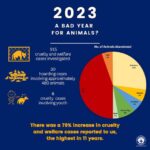In the intricate tapestry of societal values, the treatment of animals often reflects our collective conscience. As stewards of this planet, the moral obligation to protect those who cannot voice their suffering serves as a fundamental tenet of humane society. However, the harsh reality unveils a disheartening truth regarding animal cruelty—an act that echoes through the annals of injustice, often going unpunished or under-penalized. This begs the question: what consequences await those who transgress the fragile bond between humanity and the animals we share our lives with? Let’s delve into the labyrinth of U.S. animal cruelty laws and the maximum sentences they impose.
Animal cruelty laws in the United States are as varied and geographically diverse as the nation itself. Each state wields its own hammer of justice, carving out penalties that oscillate between minimal fines and substantial prison sentences. The inconsistency across jurisdictions can be likened to a patchwork quilt—some pieces are richly embroidered with stringent laws while others remain disheveled, with loose threads that fail to adequately reflect the severity of the crime.
Broadly speaking, animal cruelty can be classified into two categories: passive neglect and direct abuse. Passive neglect refers to situations where animals are denied basic necessities—food, shelter, and medical care—often due to ignorance or poverty. Direct abuse, on the other hand, encompasses acts of violence towards animals, including physical harm or intentional suffering. The legal ramifications reflect this dichotomy, with varying degrees of charges ranging from misdemeanors to felonies.
At the lower end of the spectrum, many states classify animal cruelty as a misdemeanor. In these instances, the maximum sentence usually hovers around one year of imprisonment along with monetary penalties that can amount to several thousand dollars. In some states, this leniency offers a stark contrast to the gravity of the offense, revealing a societal ambivalence towards animals. It’s a disturbing paradox where a fleeting moment of cruelty can result in far less consequence than an act of vandalism against property.
As we ascend the hierarchy of charges, aggrieved parties may find solace in the existence of felony animal cruelty laws—statutes designed to impose heavier penalties on egregious acts of violence. These felonies can lead to sentences ranging from one to five years of imprisonment in many states. In California and Michigan, for example, felony animal cruelty can entail imprisonment up to three years, showcasing a growing recognition of the severity of such transgressions. But even here, the maximum penalties often fall short of the true sorrow inflicted upon the voiceless victims.
There are notable exceptions within certain jurisdictions. For instance, in cases where the abuse is particularly heinous—child abuse, violent crime, or torture—some states permit a maximum sentence that soars to heights of five years or more. The enactment of “Ag-Gag” laws in certain states further complicates this narrative. These laws impede investigations and disclosures related to animal cruelty in agricultural settings, illustrating a systemic reluctance to confront uncomfortable truths about food production and animal welfare.
Throughout this ethical quagmire, some states have begun to unfurl initiatives aimed at enhancing animal welfare laws, signaling a budding consensus about the need for more robust penalties. In recent years, Tennessee and Illinois have introduced legislation imposing harsher sentences for repeat offenders, urging a paradigm shift that acknowledges the psychological patterns often underlying acts of cruelty. Such measures reflect a recognition that animal cruelty rarely exists in a vacuum and that early intervention can mitigate broader patterns of violence.
The legal penalties associated with animal cruelty also intertwine with training and rehabilitation programs. Some states, recognizing that punitive measures alone may not suffice, impose mandates for offenders to undergo psychological evaluation, therapy, or community service involving animal care. This multifaceted approach aims to transform the act of cruelty into an educational opportunity—an endeavor to foster empathy rather than exacerbate anger.
Moreover, public sentiment plays an influential role in shaping legislation. Communities advocating for stronger animal rights increasingly press lawmakers to align penalties with societal values that champion compassion over callousness. Campaigns featuring provocative imagery—heart-wrenching snapshots of suffering animals—have mobilized collective outrage, compelling state legislatures to reconsider outdated statutes that offer mere slaps on the wrist. The fusion of emotional narrative with the blunt language of law can create a formidable force for change, steering public discourse towards a more humane treatment of animals.
In the grand scheme of justice, the maximum sentences for animal cruelty in the United States form a complex landscape, peppered with inconsistencies yet also illuminated by pockets of progress. While various states oscillate between leniency and rigor, the cause for compassion finds its voice in the minds and hearts of the public. The challenge remains: to unify these disparate threads into a cohesive fabric that resounds with purpose and dignity for all creatures. As we embark on the journey towards a future where cruelty becomes an anachronism, let us remember that our greatest strength lies in our ability to stand and advocate for those who can offer no defense. The fight against animal cruelty is not simply a fight for animals; it is a fight for our own humanity.







